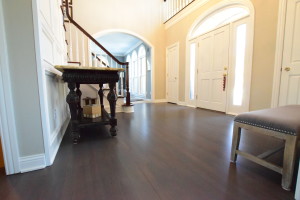Brazilian Cherry Stained Grey | Green Bay, Wisconsin
Posted by Aaron Schaalma
Looking at your current interior styling, you decide that you want to make a change. So, you obtain samples to assist you in creating a theme, to ensure that everything goes together. But wait! The hardwood flooring has such a prominent color that you think it's too difficult to do anything with. What should you do? Rip it out?


Before the floors where refinished
We recently worked with a client in Green Bay, WI, who had the same dilemma. We first had them find some pictures of floors that they really liked. (A great way to do this is to search on Houzz and create boards, and then share them with your contractor.) We were then able to get a feel and idea of what they were looking for. We were able to come up with a custom process and color, needed to create that one-of-a-kind color for them. We then started our refinishing process to remove the old coating and to expose the grain of the wood. The floor had previously been finished with a product that amber's over time. Because this floor was getting stained, extra sanding steps were required to ensure that the scratch marks were gone. In this extra step, we went around the perimeter of the room to remove any scratch marks left by the edger. Then we followed that up with the Lagler Trio, in order to blend all the edges together with the field. Because of the tight grain pattern of Brazilian Cherry, the wood needs to be conditioned with water to open the grain. Once the hardwood is conditioned, it needs to dry.

Preparing the floor for stain
(One battle we have as wood flooring professionals is that wood and water don’t mix too well and can cause issues, because water and solvents can get trapped in the wood cells if not given enough time and air movement to completely evaporate and dry.)

Stained and ready for sealer
Then, we started to stain the hardwood with our custom stain color. Once that was allowed to dry, we applied a sealer to lock in the color and block any oil that naturally occurs in Brazilian Cherry. Most exotic woods are very oily, and that adds another element to finishing exotic woods. Once the sealer had dried, we applied two coats of a waterborne commercial finish. We used a commercial finish because it has better adhesion properties and would be less affected by the oily nature of the wood flooring in this job. This is just one of the many things that can be achieved by a wood flooring artisan.
If you want a custom floor color, contact me. I’d love to talk with you and show you how my craftsmanship can create the masterpiece that’ll wow you!



After



